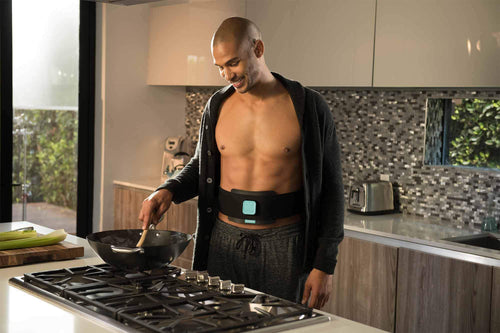If you’re inspired by the marathon season but brand new to running, our simple starters guide explains the benefits of adding some easy mileage to your exercise routine.
Why is running great for the mind and body?
- Every run results in burned calories (even after exercise) and released endorphins, helping you look and feel amazing.
- Like Slendertone abs belts, running conditions the core and abdominal muscles, including the six pack and deep transversus abdominis.
- The meditative effects of running help you to destress and can even improve sleep, mood and concentration.
- Running 5-10 minutes each day at a slow tempo helps reduce the risk of heart disease (Journal of the American College of Cardiology, August 2014).
- Running for 30 minutes 5 times per week after 40 can increase life expectancy (PLOS Medicine, December 2012).

It’s also easy to fit into busy schedules
Running the commute is a great way to swap rush hour traffic and public transport for regular exercise.
It also helps you start your mornings with more energy and allows you to destress after long days. You could even squeeze a run into your lunchbreak to boost your mood and concentration in the afternoon.
What do I need to start running today?
The beauty of running is its simplicity. You can start today with comfortable trainers, your gym kit and bottled water. If you want to make running part of your regular exercise routine, follow the tips below.
Choose a route that works for you
Choose a flat and familiar route and increase your distance as you get fitter, faster and more confident.
If you keep your running route consistent, you can easily time yourself and monitor personal progress. Joanne compliments her abs belt toning programme with short and regular runs around her local park.
“I try to complete all my laps inside 20 minutes,” she notes. “I’m pleased to say that this week I finished my final lap 30 seconds faster than normal!
“I have also increased my weekly mileage from 3 laps to 4 laps (the last laps are fast-paced walking to help warm down the legs).”
Always warm-up and warm down before and after runs to reduce aches and minimise the risk of injury.

Choose your perfect running shoes
Your unique foot shape, running style (known as your gait), weight and running surface all affect which shoes you should wear. The right shoes optimise comfort and running efficiency and minimise injuries.
Getting your gait analysed is the best way to ensure your shoes support your natural running style and optimise comfort. There are, however, some general rules which can help guide your footwear choice:
- The feet of overpronators roll inwards and tend to be flat of low-arched. Severe overpronators require motion control shoes to stabilise their stride. Mild overpronators need support shoes.
- The feet of under pronators (or supinators) roll outwards and typically have high arches. Select cushioned shoes (also known as neutral shoes) to provide some guidance to your running gait.
- Neutral shoes are also suited to runners who do not excessively under or overpronate. Neutral runners have better balance and stronger arch stability, which means they need less support.
- Heavier runners require extra cushioning to minimise shock and stress on joints and ligaments.
Add technical running socks which wick away sweat and reduce rubbing/chafing to keep feet drier and blister-free.
Take water on every run
When you’re dehydrated it’s harder to pump blood around the body, which can cause cramp and even injuries. In hot conditions, especially during spring and summer, it also increases the risk of heatstroke.
If your run is 30+ minutes, add an electrolyte tablet to you water bottle to replenish the nutrients and salts you lose through sweat.
Increase visibility
If you’re running in urban environments or low-light conditions, reflective and hi-viz running clothing will make you move visible more quickly to drivers.
If you’re running on the trails, equip a head torch so that you can spot those rocks and roots underfoot.
What are the benefits of trail running?
Off-road is a lower-impact alternative to running on harder surfaces like tarmac. It’s also gives you the opportunity to escape the concrete jungle.
“Running in the woods and over mountains just makes it so much more enjoyable,” states ultra-runner Carel, who makes abs toning part of his racing training. “Also, running on soft ground is better for your joints.”

Wear running footwear for stability on slippery and uneven terrain
If you’re running on a mixture of roads and footpaths, choose a rugged outsole for better grip. For wet and muddy hills and trails or obstacle events like Tough Mudder, deep lugs provide maximum traction.
“I wanted to strengthen my core to improve my running posture”
Slendertone abs trainers are the perfect companion for your running programme, especially when you begin to increase your mileage and enter races and fun runs.
“I wanted to enhance my core strength to improve my running posture and stay stronger for longer,” says Carel, who used Slendertone in conjunction with training for 100km ultra-marathons on the trails.
“My core has definitely firmed because I can now hold the plank position for just over 3 minutes.”
Even an ultra-athlete like Carel can improve his abdominal strength and endurance using our abs belts!


